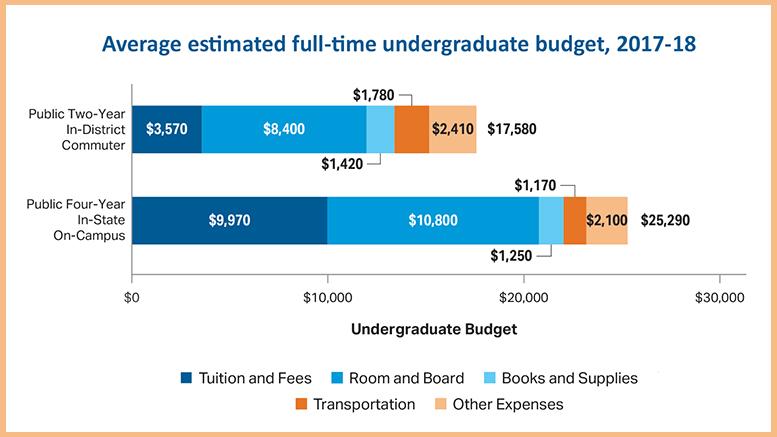On average, available student aid and tax deductions continue to fully cover tuition and fees of full-time community college students, according to the annual College Board study of college pricing trends.
The average published in-district tuition and fees at public two-year colleges increased by $100 (2.9 percent) from $3,470 in 2016-17 to $3,570 in 2017-18. Meanwhile, full-time community college students received an average of about $3,900 in grant aid and federal education tax credits and deductions, which is $330 more than needed to cover tuition and fees, the report says.
However, the difference between the published tuition/fees and grants and tax benefits has gradually decreased over the past five years, the report shows. In 2012-13, “net tuition and fees” for student was -$620, decreasing steadily to -$580 in 2014-15, and -$370 in 2016-17. Grant aid and tax benefits per students have over the same period been relatively stable between $3,900 and $4,010 (in 2016-17 and 2017-18, the amount was $3,900).
Of course, the cost of attending a community college is more than just tuition and fees. It includes living expenses and books, among other costs. The College Board noted that on average living expenses for public two-year college students total about $8,070. Community college students receiving Pell grants and other student aid often apply any overage after tuition and fees toward other college-related expenses, such as transportation and housing.
The cost of textbooks also continues to increase. The average price of new textbooks increased from $58 in 2011-12 to $80 in 2015-16, and for used books it increased over the same period by $2 to $53, according to the National Association of College Stores.
More FTE per student, but…
The report shows recent increases in full-time equivalent (FTE) funding per student — with a caveat. The data show the average subsidy per FTE student at public two-year colleges fell by 15 percent ($920) between 2004-05 and 2009-10, but increased by 14 percent ($750) between 2009-10 and 2014-15.
But that later increase was largely due to declines in enrollment. Over the 10-year period, state and local appropriations have dropped from 58 percent to 52 percent, according to the report. Meanwhile, enrollments dropped over that same period by 11 percent (908,000 students), resulting in an increase in FTE funding.
Meanwhile, community colleges are relying more on net-tuition revenue, which comprise one-third of their total revenue compared to 27 percent in 2004-05. Federal funding — which includes federal appropriations, grants and contracts — has been steady at 15 percent to 16 percent over the same period.
State breakdowns
A dozen states had published 2017-18 in-district tuition and fees that fell below the national average of $3,570, including: California, New Mexico, North Carolina, Texas, Arizona, Kansas, Mississippi, Nebraska, Wyoming, Nevada, Florida and Missouri.
In six states — California, Florida, Ohio, Wisconsin, Minnesota and New Hampshire — average tuition and fees at public two-year colleges fell in inflation-adjusted dollars between 2012-13 and 2017-18, the report says.
Seven states — Mississippi, Wyoming, Arkansas, Idaho, Louisiana, Oklahoma and West Virginia — saw increases of more than 20 percent over the same period. The report noted that, even though Mississippi saw a 29 percent increase over the five-year period, its 2017-18 price was still $450 less than the national average.
The report also noted that the taking California out of the mix would slightly increase the national average, as the state enrolls about 18 percent of the nation’s full-time public two-year students and has the lowest average tuition and fees at $1,430.

